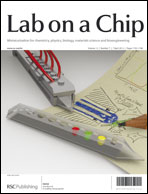
A multifunctional pipette
Alar Ainla, Gavin D. M. Jeffries, Ralf Brune, Owe Orwar and Aldo Jesorka
DOI: 10.1039/C2LC20906C

Engineers are from PDMS-land, Biologists are from Polystyrenia
Erwin Berthier, Edmond W. K. Young and David Beebe
DOI: 10.1039/C2LC20982A
Another HOT article in this issue is by Serge G. Lemay and colleagues at the MESA+ Institute for Nanotechnology, University of Twente, reporting on their study of the response time of nanofluidic thin-layer cells as electrochemical sensors, and suggested means of improving that time.
Response time of nanofluidic electrochemical sensors
Shuo Kang, Klaus Mathwig and Serge G. Lemay
DOI: 10.1039/C2LC21104A
This issue also features the latest article in our Acoustofluidics series, by Thomas Laurell and colleagues at Lund University, Applications of acoustophoresis in continuous flow microsystems; and our latest Research Highlights from Ali Khademhosseini and colleagues.
As usual, all our HOT articles are free to access for four weeks (following a simple registration for individual users).










